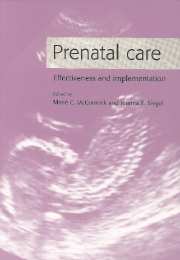Book contents
- Frontmatter
- Contents
- List of contributors
- Foreword
- Acknowledgments
- Introduction
- Part I Prenatal Care and Complications of Pregnancy
- Part II Preventing Prematurity
- Part III New Findings and Long-term Evidence on Intrauterine Growth Restriction
- Part IV Preventing and Treating Birth Defects
- Part V Prenatal Care as an Integral Component of Women's Health Care
- 12 Opportunities for improving maternal and infant health through prenatal oral health care
- 13 Family planning: need and opportunities
- 14 Maternal–fetal conflict is not a useful construct
- 15 Linking prenatal care with women's health care
- 16 A European perspective on prenatal care: an integrated system
- Epilogue
- Index
12 - Opportunities for improving maternal and infant health through prenatal oral health care
Published online by Cambridge University Press: 17 August 2009
- Frontmatter
- Contents
- List of contributors
- Foreword
- Acknowledgments
- Introduction
- Part I Prenatal Care and Complications of Pregnancy
- Part II Preventing Prematurity
- Part III New Findings and Long-term Evidence on Intrauterine Growth Restriction
- Part IV Preventing and Treating Birth Defects
- Part V Prenatal Care as an Integral Component of Women's Health Care
- 12 Opportunities for improving maternal and infant health through prenatal oral health care
- 13 Family planning: need and opportunities
- 14 Maternal–fetal conflict is not a useful construct
- 15 Linking prenatal care with women's health care
- 16 A European perspective on prenatal care: an integrated system
- Epilogue
- Index
Summary
Introduction
It is not unusual for oral health to be overlooked by those responsible for organizing prenatal care programs, regardless of whether the programs are clinical or educational in nature. After all, until recently, the most commonly cited link between pregnancy and oral health in the clinical literature was a poorly understood and largely inconsequential condition known as “pregnancy gingivitis” (Carranza, 1996). However, applications of modern scientific techniques during the past decade have provided greater insights into the likely etiology of this common phenomenon, and also have demonstrated significant links between conditions in the mouths of mothers and the future oral health of their infants. Other recent epidemiological and laboratory studies have directed attention to a possible link between maternal oral health and the course and outcomes of pregnancy in some women.
For this reason, it seems timely and appropriate to review the available evidence on oral health and pregnancy. This chapter provides an overview of the current state of knowledge about these topics along with suggestions for achieving broader, more integrated involvement among health care professionals and prenatal program administrators in health promotion related to oral health. It begins with a review of common oral health problems, which may be exacerbated during pregnancy, but which may be minimized or prevented through effective prenatal care. Because it may be unfamiliar to many involved with prenatal care, the etiology of conditions affecting oral health is emphasized in this discussion.
- Type
- Chapter
- Information
- Prenatal CareEffectiveness and Implementation, pp. 261 - 270Publisher: Cambridge University PressPrint publication year: 1999



